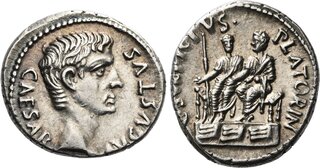| Numismatica Ars Classica > Auction 143 | Auction date: 7 May 2024 |
| Lot number: 481 Price realized: This lot is for sale in an upcoming auction - Bid on this lot  | Show similar lots on CoinArchives Find similar lots in upcoming auctions on |
| Lot description: The Dioscuri Collection. The Roman Empire. Octavian 32 – 27 and as Augustus, 27 BC – 14 AD. Roma C. Sulpicius Platorinus. Denarius 13 BC, AR 19 mm, 3.98 g. CAESAR – AVGVSTVS Bare head r. Rev. C SVLPICI – VS PLATORIN Augustus and Agrippa, both togate, seated half l. on bisellium set on platform ornamented with rostra. On l., staff upright. C 529. BMC 15. RIC 407. CBN 539. Rare and in exceptional condition for the issue. Lovely iridescent tone and good extremely fine Ex NAC sale 59, 2011, 891. An important feature of the Augustan political program was to give the impression that while Augustus had assumed full power over the Roman state, the Republic still lived on. This illusion was important to avoid the fate suffered by Julius Caesar when he brazenly took up the trappings of kingship. As a means of propping up the Republican image, Augustus resurrected old Roman religious traditions and magistracies that had fallen into disuse during the civil wars of the first century BC. This denarius firmly belongs to the Augustan Republican illusion through several notable features. Whereas earlier denarii had emphasised the emperor's unique qualities and powers by depicting him wearing the corona civica granted to him by the Senate in 27 BC, here the portrait of Augustus is shown bare headed in conformity with old Republican custom, as if to emphasise his disingenuous claim to be merely primus inter pares, "first among equals." Likewise, the reverse illustrates Augustus' revival of the Republican office of moneyer. The surrounding legend names C. Sulpicius Platorinus as the moneyer responsible for the issue. However, at the same time that the coin is imbued with these pseudo-Republican qualities, the reverse type is decidedly monarchical in character. It depicts Augustus and Marcus Agrippa seated side by side to illustrate their equal status and mark out the latter as the intended heir of Augustus. Under the constitutional settlement of 23 BC, Augustus had established Agrippa as his intended heir, granting him proconsular imperium in imperial provinces and arranging a marriage to Augustus' daughter Julia the Elder. In 18 BC, a few years before this coin was struck, Agrippa's powers were made virtually equivalent to those of Augustus by a grant of tribunicia potestas and imperium in all provinces of the empire. Unfortunately, despite all of this, Agrippa died in 12 BC, the year after this coin was issued, thereby frustrating all of Augustus' carefully devised plans for a smooth succession and forcing him to seek new suitable heirs. Estimate: 6000 CHF |  |



